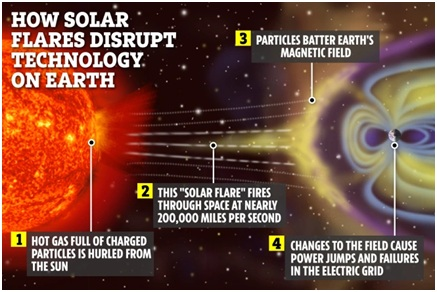

16th April 2022 (7 Topics)
Context
A strong geomagnetic storm has been predicted to hit the earth on April 14-15, 2022.
- The Centre for Excellence in Space Sciences, India said that there is a “very high probability of earth impact” due to solar activity causing the phenomenon.
About
Geomagnetic storm:
- A geomagnetic storm is a disturbance in the earth’s magnetosphere, which is the area around the planet controlled by its magnetic field.
- The earth’s magnetosphere protects its inhabitants from most of the particles emitted by the sun.
- When a coronal mass ejection (CME) or a high-speed stream reaches the earth, it strikes the planet’s magnetosphere.
- If the incoming solar magnetic field is directed southwards, it interacts strongly with the earth’s own magnetic field that is opposite in direction, causing disturbances.
- The changes produced in the earth’s magnetic field as a result of this interaction allow solar wind particles to stream down the magnetic field lines and hit the atmosphere near the poles.
- Solar winds deeply impact the shape of the earth’s magnetosphere, and variations in solar winds cause geomagnetic storms on earth.
- At the surface of the earth, a geomagnetic storm can result in a rapid decline in the earth’s magnetic field strength. This decrease can last for around 6 to 12 hours and gradually recovers over several days.
- Sunspots are dark areas on the solar surface and contain strong, shifting magnetic fields. These are formed when areas on the surface of the sun cool slightly – from around 6,000 °C to about 4,200 °C — due to strong magnetic fields that emerge through the solar surface. Sunspots appear as dark spots against the otherwise bright sun.
Coronal Mass Ejection (CME):
- A coronal mass ejection is a large expulsion of plasma and magnetic field from the sun’s corona.
- Plasma is the highly ionised gas present on the sun, while corona is the outermost part of the sun’s atmosphere.
- The corona is structured by strong magnetic fields. If these fields are closed, the solar atmosphere can release sudden, violent bubbles of gas and magnetic fields which constitute the CME.
- One large CME is capable of containing a billion tonnes of matter.
- CMEs can travel at varying speeds – as slow as 250 km per second to as high as 3,000 km per second.
What are the hazards associated with geomagnetic storms?
- According to the U.S. Geological Survey (USGS), geomagnetic storms can impact long-range radio communication and global positioning system (GPS) devices.
- These storms can also damage satellite electronics and expose astronauts and high-altitude pilots to increased levels of radiation.
- Voltage surges due to altered magnetic activity can also affect power supply on the earth and cause outages.
- Geomagnetic storms are also linked with intensified northern lights visible in the skies of higher latitudes.
|
What is a Solar Storm?
Types of Solar Storms: Solar Storms come in the form of the following types:
|


